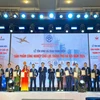The struggling Vietnam car making industry is already turning to importing vehicles well before the country joins the ASEAN Free Trade Area (AFTA) in 2018.
A report from the Vietnam Automobile Manufacturers' Association (VAMA) showed that its members sold 92,000 units in 2012, a fall of 33 percent compared with 2011.
When the presently high taxes dropped to zero in 2018, cars from ASEAN countries are expected to flood into Vietnam.
Toyota Motor Vietnam (TMV) will display Lexus cars from Japan at the Vietnam Motor Show to be held in Ho Chi Minh City in October. Honda Vietnam also plans to sell imported cars.
According to Honda Vietnam's sales manager, Tomohiro Maruto, after three months of launching the model, the company has received more than 1,600 orders but delivered only about 300 units. It has raised production capacity to 600 units a year, but this is still not enough. The company also plans to import the Accord model by the end of this year.
Mitsubishi, whose strong position in four-wheel-drive vehicles, will also display two small sedans for women motorists at the motor show in Ho Chi Minh City.
And Ford Vietnam has recently started to import the pick-up Ranger from Thailand.
According to the Vietnam Customs, more than 23,000 completely-built units have been imported to Vietnam so far this year, a 22.5 percent increase compared with the same period last year. Of these, 11,100 were cars and 10,000 heavy vehicles.
Deputy Director of Vinastar, Kiyoshi Teshima, said Mitsubishi had been assembling cars and selling imported ones.
At present, most cars from ASEAN sold in Vietnam come from Thailand and Indonesia. In the future, cars imported from the Republic of Korea, China and Japan are expected to increase strongly.
Although the three countries are not members of ASEAN, the regional group will reduce their import taxes to 5 percent by 2018.
Many car makers in Vietnam said that price cuts were necessary because the import tax on spare parts in Vietnam was high while it does not exist in Thailand and Indonesia.
They said to lower prices, they needed more locally-made spare parts, but the country's support industry was still weak.-VNA
A report from the Vietnam Automobile Manufacturers' Association (VAMA) showed that its members sold 92,000 units in 2012, a fall of 33 percent compared with 2011.
When the presently high taxes dropped to zero in 2018, cars from ASEAN countries are expected to flood into Vietnam.
Toyota Motor Vietnam (TMV) will display Lexus cars from Japan at the Vietnam Motor Show to be held in Ho Chi Minh City in October. Honda Vietnam also plans to sell imported cars.
According to Honda Vietnam's sales manager, Tomohiro Maruto, after three months of launching the model, the company has received more than 1,600 orders but delivered only about 300 units. It has raised production capacity to 600 units a year, but this is still not enough. The company also plans to import the Accord model by the end of this year.
Mitsubishi, whose strong position in four-wheel-drive vehicles, will also display two small sedans for women motorists at the motor show in Ho Chi Minh City.
And Ford Vietnam has recently started to import the pick-up Ranger from Thailand.
According to the Vietnam Customs, more than 23,000 completely-built units have been imported to Vietnam so far this year, a 22.5 percent increase compared with the same period last year. Of these, 11,100 were cars and 10,000 heavy vehicles.
Deputy Director of Vinastar, Kiyoshi Teshima, said Mitsubishi had been assembling cars and selling imported ones.
At present, most cars from ASEAN sold in Vietnam come from Thailand and Indonesia. In the future, cars imported from the Republic of Korea, China and Japan are expected to increase strongly.
Although the three countries are not members of ASEAN, the regional group will reduce their import taxes to 5 percent by 2018.
Many car makers in Vietnam said that price cuts were necessary because the import tax on spare parts in Vietnam was high while it does not exist in Thailand and Indonesia.
They said to lower prices, they needed more locally-made spare parts, but the country's support industry was still weak.-VNA



















